
2019-01-05_The_Economist
.pdf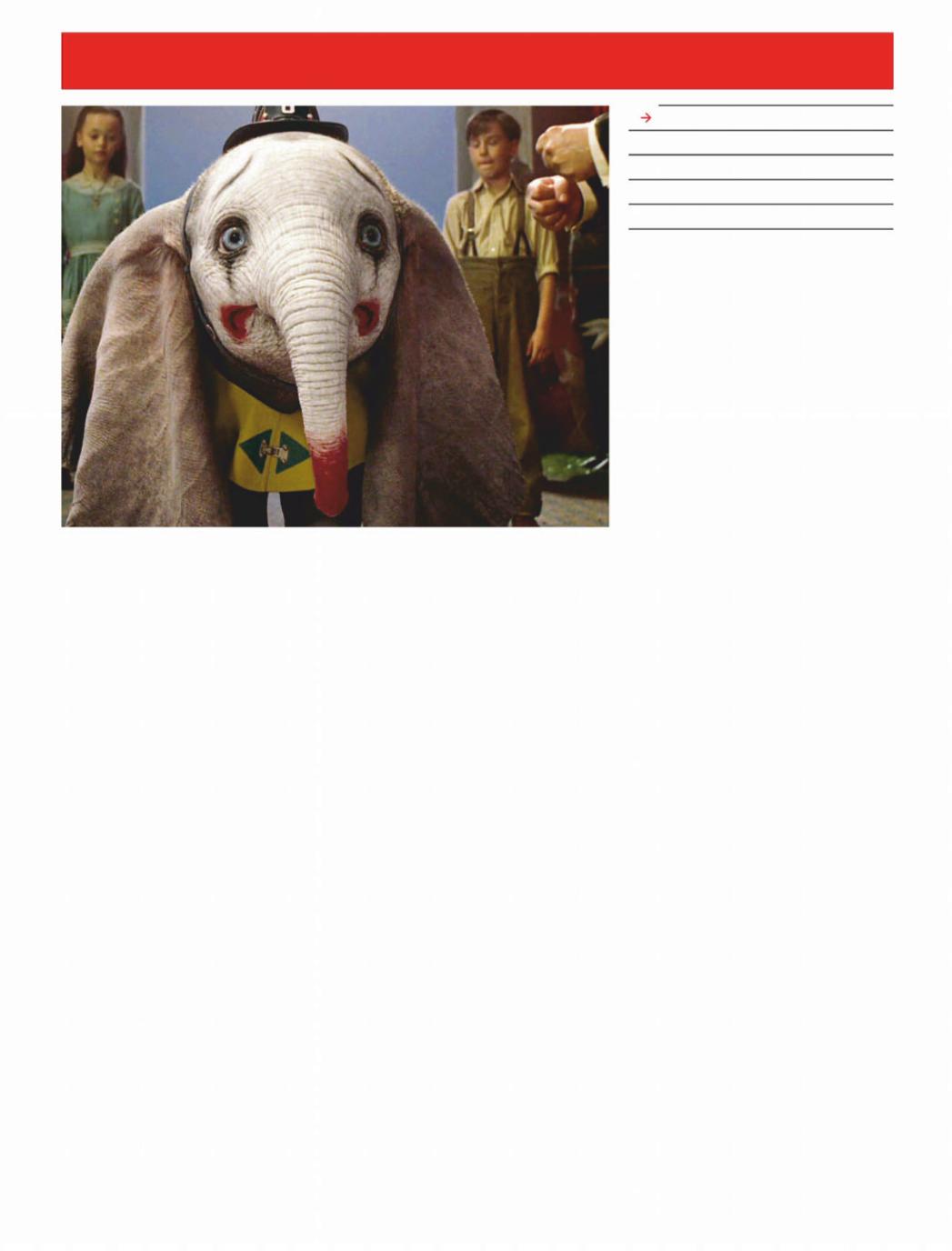
vk.com/id446425943
58 Books & arts
Disney goes back to the future
An old new world
Live-action remakes of classic cartoons are one of the most lucrative innovations in cinema
In january 1991 Je rey Katzenberg, then chairman of Walt Disney Studios, sent a 28-page memo to his colleagues. Entitled “The World is Changing: Some Thoughts on Our Business”, it lamented that the studio had lost its way. The finances were sound—Disney had outdone its competitors at the box o ce the year before—but Mr Katzenberg felt the company was unduly focused on blockbusters. It should be less fixated on big budgets, big names and whizzy e ects, he urged, and concentrate on developing original ideas and executing them well. “People don’t want to see what they’ve already seen,” he said. “Our job is not to count on recycled formulas, but to
create and develop fresh, new stories.” His advice now seems quaint. Of the ten
most expensive films ever made, Disney is responsible for six. In 2012 the studio hired Alan Horn as its chairman after a successful stint at Warner Brothers, where he had devoted a hefty share of the budget to a handful of “event films”, such as the Harry Potter series. If the average American only sees around five movies a year, he reasoned, they are most likely to opt for “something of high production value, be it because of the story, or the stars involved, or the special visual e ects”.
That approach can backfire. One calculation by Stephen Follows, a film consultant, implies that half of Hollywood productions with budgets over $100m lose money. When Mr Horn arrived at Disney, it was lurching towards two of the worst-ever box-o ce flops. “John Carter” (2012) and “The Lone Ranger” (2013), a pair of untried action stories, lost around $200m each. But since then the studio seems to have found a magic formula: extravagant remakes of animated fantasies that audiences already love. Discounting Mr Katzenberg’s dim view of blockbusters can evidently be risky, but big bets seem safer if film-makers eschew his yen for novelty, too. Or so Disney’s recent record suggests.
Never-ending story
“Cinderella” (2015) made $535m from a budget of $95m. “The Jungle Book” (2016) took $963m from $175m. The $300m marketing and production budget of “Beauty and the Beast” (2017), starring Emma Watson, Emma Thompson, Ewan McGregor and Ian McKellen, made it the most expensive musical ever. Within ten days of its release it was the highest-grossing film of its genre, eventually making $1.2bn in ticket sales. According to the Hollywood Reporter,
The Economist January 5th 2019
Also in this section
59A novel of twins and Trinidad
60The life of Calouste Gulbenkian
60Asia’s waterways
61Johnson: Disposing of defunct words
Disney has been the most profitable studio for the past four years, earning more than $7bn at the global box o ce in 2016 and 2018. Its share price has risen by more than 150% since 2012.
Princesses and talking animals are not the only characters to have been summoned back to the screen: audiences have been swamped by hordes of wizards, capewearers, dinosaurs and Jedi. But in this fairy-tale realm, Disney has an edge. Generations of children grew up on its animated backlist, and enough time has passed to retell the classics using new technology (and for fans to take children of their own). Reboots of old flicks have actually become less common in Hollywood overall, falling from 17% of top films in 2005 to 4% in 2017 (though prequels and sequels abound). But they are one of Disney’s staples. In 2019 it will add “Dumbo”, “Aladdin” and “The Lion King” to its roster of “live-action remakes”, which replace the original cartoons with filmed footage and computer-generated imagery. “Pinocchio”, “Snow White”, “James and the Giant Peach”, “Peter Pan” and “The Little Mermaid” will follow.
A crucial step in these renovations is to tap into the films’ existing fan base by zealously monitoring online forums and quizzing focus groups. A few purist fans decry any updates, such as the redesign of Mrs Potts, an enchanted teapot, in “Beauty and the Beast”. But the typical viewer covets the big moments—the waltz in “Beauty and the Beast”, or Simba held aloft on the African plains—while being less fussy about the details. That leaves room for plot changes and character development. “We looked back a lot at what Walt Disney had done,1
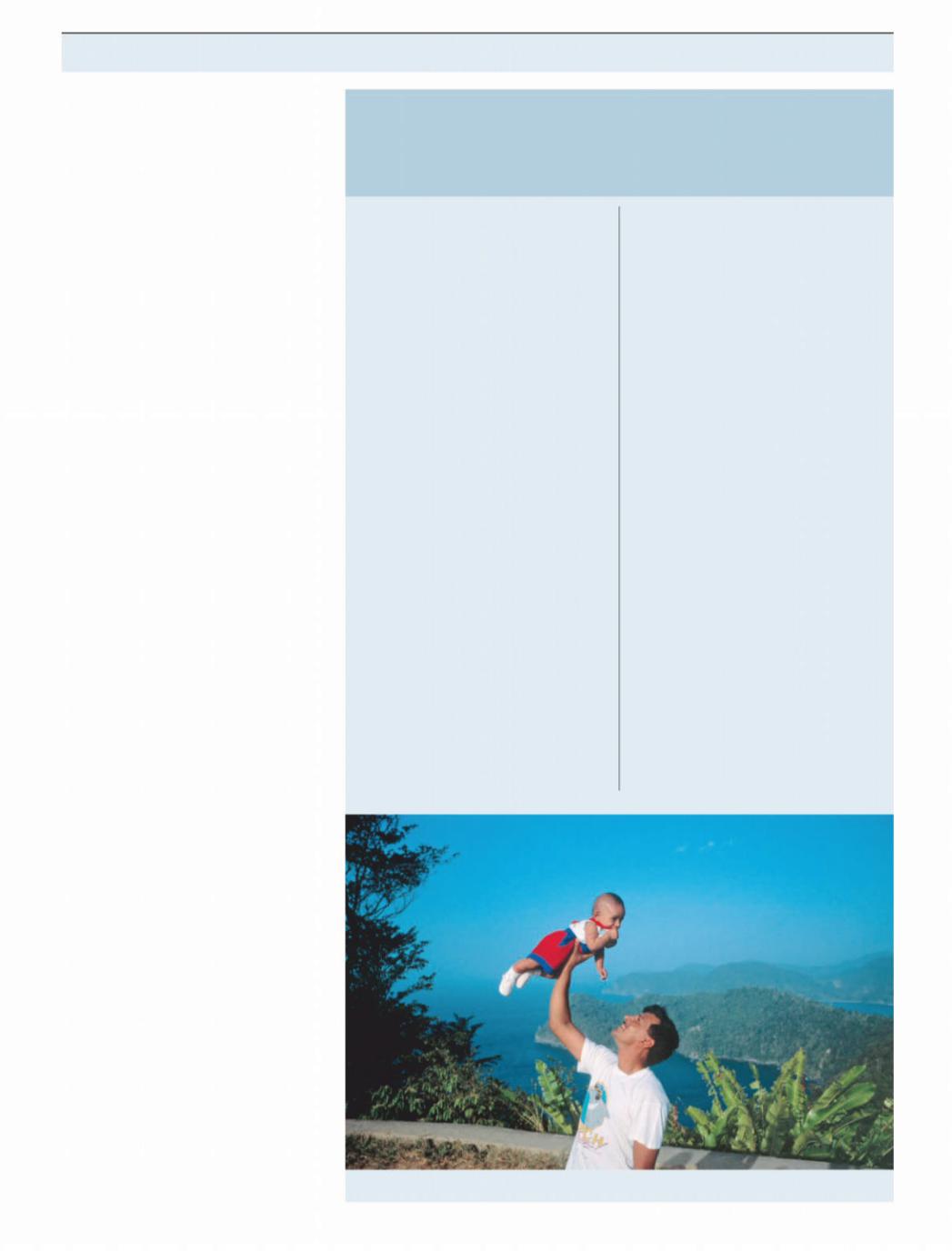
vk.com/id446425943
The Economist January 5th 2019
2 not in terms of specifics but in terms of spirit,” explains Sean Bailey, the studio’s president of production. The original Disney identified stories that had enduring appeal and adapted them to his era, Mr Bailey says; “then he applied the very best talent and technology that he could.”
Today that means attracting stars—Ms Watson as Belle, Donald Glover and Beyoncé as Simba and Nala, Will Smith as the Genie—and directors who reinforce each title’s strengths. Tim Burton is a good fit for a story about a persecuted circus elephant and a nefarious entertainment magnate, because Dumbo’s outsider status is “a central characteristic that also runs through all of [Mr Burton’s] work”, according to Derek Frey, the film’s producer. Guy Ritchie’s aptitude for raucous action sequences lends itself to “Aladdin”, a fable about a mischievous street urchin.
Producers and directors can now draw on astoundingly sophisticated computergenerated e ects. Except for the actor who played Mowgli, “The Jungle Book” was entirely digital; the authentically lush rainforest and convincing animals earned an Oscar. Jon Favreau, the director, will apply the same techniques to “The Lion King”. “We can put any animal next to a real one and not be able to tell the di erence,” claims Richard Stammers, the visual-ef- fects supervisor on “Dumbo”. The animators size up muscle, the wrinkles of skin and the movement of fur. Lacking an airborne elephant to copy, researchers studied the physics of large birds. For imaginary creatures such as the Beast, animators use the latest motion-capture technology, which tracks actors’ movements and facial expressions and then transposes them onto digital figures. The uncanny realism instils a sense of wonder of its own.
These revamps are not the only way Disney is ransacking its canon. In 2018 it released “Mary Poppins Returns” and a film about Christopher Robin, a pal of Winnie- the-Pooh’s; Cruella de Vil, Rose Red (Snow White’s sister), Tinker Bell and Prince Charming are all in line for their own movies. Fears that Disney would tarnish its family heirlooms with these do-overs and spin-o s seem to have been unfounded. On Rotten Tomatoes, a review-aggregator site, audiences give “The Jungle Book” an 86% approval rating—a similar score to the original’s, as is that of the new “Cinderella”.
Still, Mr Katzenberg’s insistence on “fresh, new stories” has not been wholly discredited. There are only so many venerable cartoons to revisit, and the exciting novelty of seeing real actors and realistic animals breathe life into fantastical yarns may fade. Franchise apathy has already struck: “Solo: A Star Wars Story” (2018) received decent reviews but failed to break even. The circle of live-action films may yet turn out to be a wheel of fortune. 7
Books & arts 59
Fiction from Trinidad
His brother’s keepers
Golden Child. By Claire Adam. SJP for Hogarth; 288 pages; $26. Faber & Faber; £14.99
Twins make up only a small fraction of the population but loom disproportionately large in literature. They are handy for storylines involving mistaken
identity and creepy synchronicity, and o er the chance to show how people whose lives begin in the same place can take drastically di erent paths. A contrast between dissimilar twins is at the heart of “Golden Child”, Claire Adam’s assured and compelling first novel, which is set in rural Trinidad, where she grew up, during the1980s.
Unlike Viola and Sebastian in
“Twelfth Night”, Peter and Paul Deyalsingh do not appear to be “An apple, cleft in two”. Not at all. Paul “tends to slink around”, while Peter “walks with a bold step”. The boys—aged13 when the book opens—have been treated di erently from the beginning. Paul was deprived of oxygen at birth; a doctor suggested to the twins’ father, Clyde, that “mental retardation” might have resulted.
The family accepts this diagnosis as fact. And, true to expectations, as they develop Paul does not share Peter’s genius for learning. Eventually a conscientious schoolteacher, Father Kavanagh, tries to delve beneath the assumption that Paul is “slow”. Who told him he was retarded? “I don’t know,” the boy replies
poignantly. “It’s just—it’s just how it is. Nobody said so, it’s just so.”
The children’s parents take opposite approaches to the disparity between their o spring. Their mother, Joy, wants them to be kept together so that Paul, the more vulnerable, can be protected by Peter. Clyde is more concerned that Peter—his golden child—should be allowed to thrive, and to leave Trinidad for his education, without being weighed down by his slower brother. However dazzling Peter’s talent may be, Clyde’s obsessive focus on safeguarding his future at any cost bodes ill.
Ms Adam’s depiction of Trinidad is intimate and wry. On her island, no one listens to the weather bulletins during the dry season as it takes “ten minutes just to say that tomorrow will be hot with no rain.” More darkly, while the nightly news might begin with a montage of “smiling children dressed as butterflies”, they are soon replaced by reports of “fatalities, domestic murders, missing people being dragged out of the bush in bodybags, or their charred remains found in burnt-out cars.”
An uncle of the twins is murdered by bandits. When Paul goes missing, everyone fears the worst. Clyde is confronted with a terrible dilemma, reminiscent of “Sophie’s Choice”, which the author explores without flinching. This is a tough, original novel of remarkable poise and confidence.
Disenchanted isle
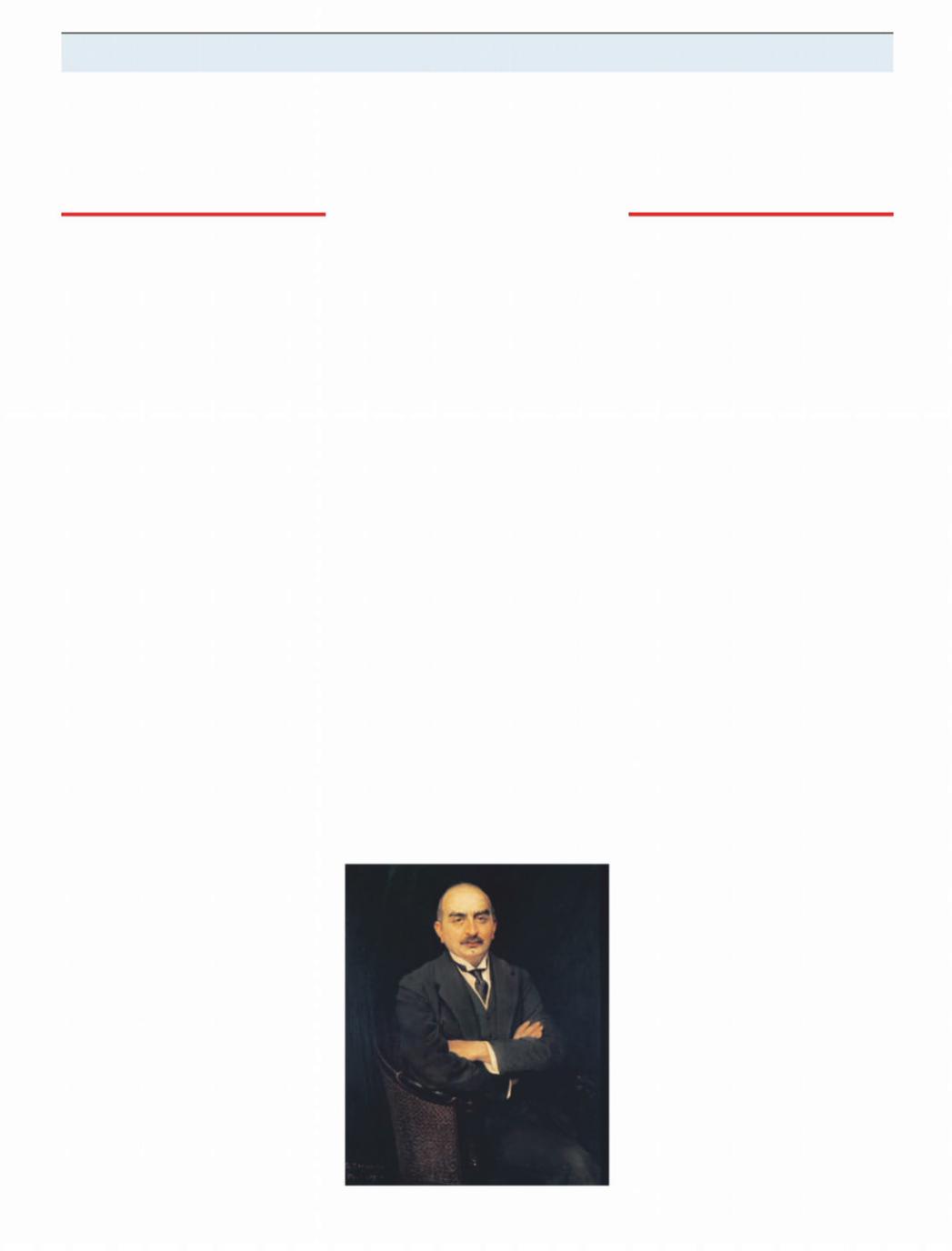
vk.com/id446425943
60 Books & arts
Calouste Gulbenkian
Fire sales
Mr Five Per Cent. By Jonathan Conlin.
Profile Books. 416 pages; £25
The end of the Ottoman era is generally described in one of two ways. In the first, a moribund empire that had oppressed its Christian subjects began to annihilate them. In the other version, the Christians colluded with foreigners to dismember an Islamic realm in which they had lived quite safely. The life of Calouste Gulbenkian, a tycoon and philanthropist who helped to shape today’s oil industry,
o ers a nuanced third perspective.
An Armenian with deep roots in central Anatolia, Gulbenkian emerged from the heart of the Ottoman Christian world. As Jonathan Conlin shows in his meticulous biography, he epitomised one of the striking features of late Ottoman history: a final burst of economic expansion that was made possible by the capital and expertise of prominent Christians, from Greek bankers to globe-trotting Armenian traders. An easy interlocutor with European grandees, he also had an insider’s understanding of the region then called the Near East. His chameleonic empathy made him a superb broker of many-sided deals that seemed to satisfy all parties, including himself.
Gulbenkian was born in 1869 to a father with growing oil interests in the Caucasus and Mesopotamia, attending French lycées and King’s College London. After Ottoman Armenians had su ered a wave of killing, he returned to London in 1897; soon he was building connections in the world of fi- nance. In 1907 he helped to bring together the two companies that formed Royal Dutch Shell.
But he plunged back into Ottoman affairs when a window opened to serve the empire. Right up to 1914, he advised the Young Turks who had seized the reins of Ottoman power as they pushed back against their European economic overlords, artfully playing one against another. Working closely with Cavid, the finance minister, Gulbenkian founded both a new National Bank of Turkey and the Turkish Petroleum Company (tpc), which had a careful balance of Western shareholders.
The window soon snapped shut. Starting in 1915, as this book somewhat laconically notes, “between a third and a half of the world’s Armenians died on forced marches,” from “exhaustion, starvation or disease” or by the bullets of Ottoman soldiers and their Kurdish accomplices. Although Gulbenkian drafted a will which
provided for the relief of Armenian orphans, his people’s tragedy does not seem to have been a preoccupation at that time; instead he was busy managing a somewhat turbulent relationship with Henri Deterding, a fellow oil magnate. He might easily have played a part in lobbying for an Armenian homeland after the Ottoman defeat, but he kept aloof.
The first world war put an end to Turkish control over the oilfields of present-day Iraq, but not to the tpc. In 1928 the com- pany—whose many shareholders included Gulbenkian himself—struck a deal to extract those deposits. His 5% stake made him fabulously wealthy, and a great collector of art at his Parisian residence, though Mr Conlin presents him as a man driven more by the thrill of commerce itself than by Mammon.
During the second world war Gulbenkian was an envoy of the Iranian government to the collaborationist French regime, and was duly proclaimed an enemy alien by Britain. But his establishment friends chimed in to see that he was forgiven after 1945, although he lived the rest of his life in Lisbon (where he endowed a well-known philanthropic foundation). It might almost be said that Gulbenkian treated outbreaks of ethnic hatred and war as a kind of nuisance to be pragmatically overcome while building commercial alliances and orchestrating oil supplies.
As well as compellingly tracing his professional dealings, Mr Conlin’s book evokes Gulbenkian’s dysfunctional family. Among the memorable revelations is that in middle age he was told by an Armenian doctor to have sex with multiple young women, advice that was followed and apparently tolerated by his long-su ering wife. Yet for all the rich detail, quite what he made of the violent collapse of the empire in which he was born remains something of a mystery. 7
Oil and troubled waters
The Economist January 5th 2019
Water in Asia
After the floods
Unruly Waters: How Rains, Rivers, Coasts
and Seas Have Shaped Asia’s History. By Sunil Amrith. Basic Books; 416 pages; $35. Allen Lane; £25
On the last day of 1956 Jawaharlal Nehru, first prime minister of an indepen-
dent India, took Zhou Enlai, his Chinese |
|
counterpart, to visit the Bhakra dam, on the |
|
Sutlej river in the north of the country. |
|
“These are the new temples of India, where |
|
I worship,” he told his visitor. Both young |
|
governments saw managing water as a cen- |
|
tral part of their mandate. In Chinese my- |
|
thology, civilisation dates from the e orts |
|
by the Emperor Yu to tame the floods 4,000 |
|
years ago. Meanwhile Indian history has |
|
been a long battle to predict, harness and |
|
exploit the monsoon—or to cope with its |
|
failure. Tens of thousands of farmers have |
|
recently taken to the streets to vent their |
|
anger at the hardship they are enduring |
|
after weaker-than-usual rains. |
|
As Sunil Amrith notes in his enthrall- |
|
ing, elegantly written and, ultimately, pro- |
|
foundly alarming history, nowhere “has |
|
the search for water shaped or sustained as |
|
much human life as in India and China.” |
|
Between them they have perhaps 36% of |
|
the world’s population, but just 11% of its |
|
freshwater—and, in both countries it is |
|
distributed hugely unevenly. Their hydrau- |
|
lic priorities have di ered: “India’s great |
|
need was irrigation; China’s was flood con- |
|
trol.” But their approaches have had much |
|
in common: the massive investment of la- |
|
bour, capital and technology in a drive to |
|
contain and control the forces of nature. |
|
The dams are an obvious symbol of this. |
|
Mr Amrith concentrates mainly on India, |
|
using China for comparison and contrast. |
|
He notes that more than 40m people in In- |
|
dia have been displaced by dam-building. |
|
In China under Mao Zedong, an estimated |
|
22,000 large dams were constructed. And |
|
the frenzy continues. More than 400 dams |
|
are planned by China, Pakistan, Bhutan |
|
and Nepal in the Himalayas, source of |
|
Asia’s ten great rivers. |
|
But dams are only part of the story. Both |
|
India and China have long nurtured gran- |
|
diose visions of linking and diverting riv- |
|
ers to mitigate the inequity of nature’s dis- |
|
tribution. Thanks to the most expensive |
|
infrastructure project the world has ever |
|
seen, two-thirds of Beijing’s tap-water now |
|
comes from a reservoir in central China, |
|
nearly 1,500km (930 miles) away. India has |
|
dreams of “interlinking” 37 rivers through |
|
14,000km of canals. |
1 |
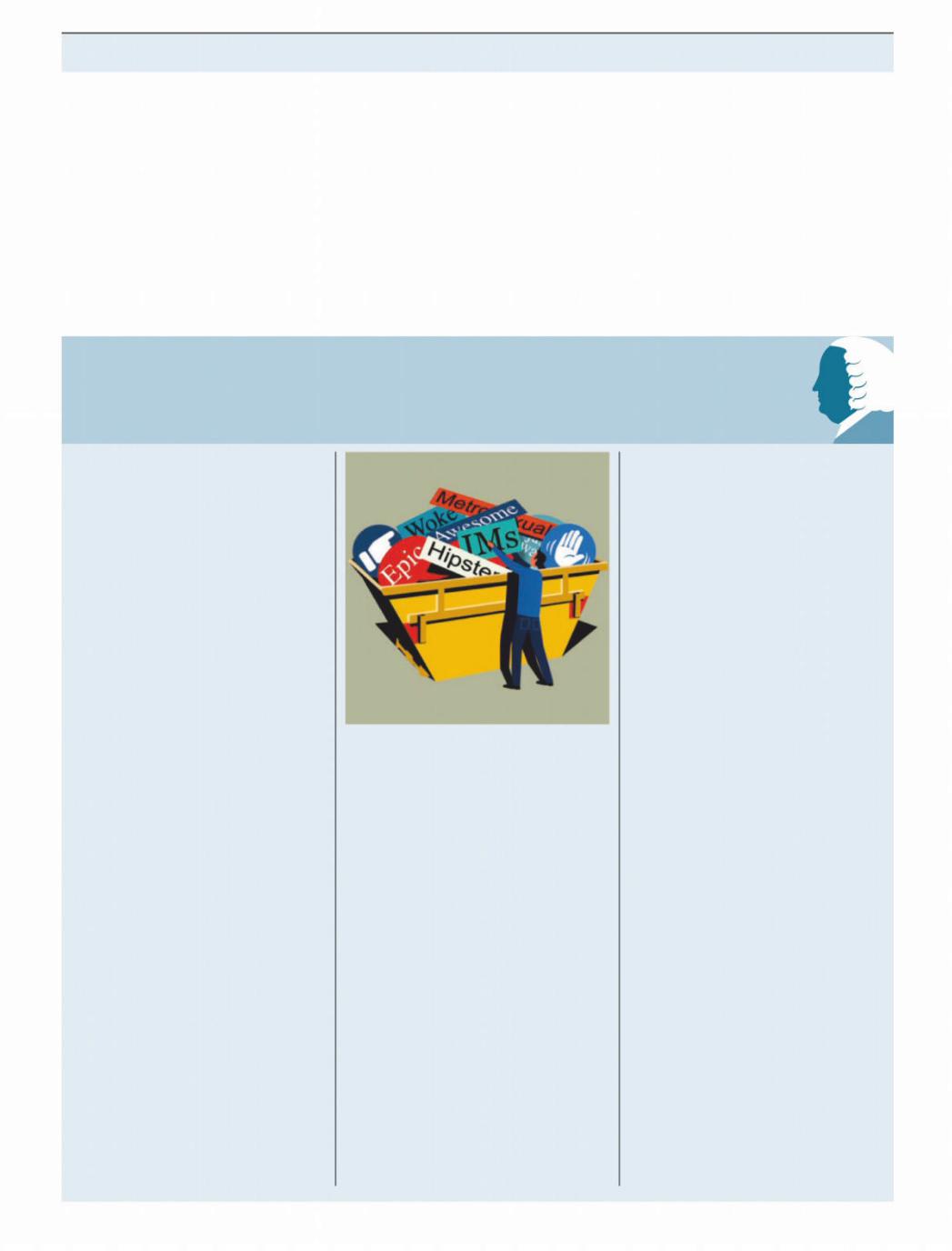
vk.com/id446425943
The Economist January 5th 2019 Books & arts 61
2 And both countries have sucked ever increasing volumes of water from underground. The Green revolution in India, which, in the 1970s, transformed its ability to feed itself, relied on electric tube wells. Groundwater now accounts for 60% of India’s irrigated area; agriculture’s share of total energy use climbed from 10% in 1970 to 30% by 1995—encouraged in part by the cheap or free electricity that Indian politicians love to lavish on rural voters when elections loom.
The inspiring element of this chronicle is simple: a huge increase in human life,
health and happiness. Water management, and the agricultural production it has sustained, have irrigated China’s economic miracle. And India, after the repeated drought-induced famines inflicted by British rule, and its dependence on food aid into the1960s, has become a big agricultural exporter.
The alarming aspect comes in the evidence Mr Amrith marshals to suggest that past strategies have run their course, and indeed are now causing new problems. Depleted aquifers, polluted waterways and silted-up dams threaten renewed and more
intense water crises—which will be exacerbated by climate change. And as water management becomes an ever more pressing concern at home, it will create tension across borders.
Already India and Pakistan are arguing about how to interpret the treaty they signed in 1960 on sharing the waters of the Indus river. And of all the insecurities India harbours about China’s long-term aims, perhaps none is as visceral as the worry about the future of the great subcontinental rivers—the Indus and the Brahmapu- tra—that rise in the Chinese Himalayas. 7
Johnson When hipsters ruled the world
A selection of words that you can safely toss out of your vocabulary
For many people, new year’s resolutions entail a clean-out of the cupboard or the basement. All those onceuseful but now clapped-out gadgets,
outmoded or too-small clothes, the cables to devices long since lost, the book that, once read, will never be opened again—o they go to be recycled.
Like households, language is tidied and renovated, but constantly rather than once a year. Just as you no longer use the chargers for discarded phones, you can safely forget a generation of earlier tech vocabulary. Nobody “instantmessages” anyone anymore; stand-alone chat services have given way to versions integrated into smartphones or platforms such as Facebook and Slack. Speaking of Facebook, you may not realise that the “Poke” and “Wave” features still exist, though hardly anyone uses them, or the attendant terms.
But technical obsolescence need not dictate the linguistic kind. Computers remind users of their early days every time they “boot” them. Once, computers could not store their own operating systems. Since it is hard to load software (including an operating system) without already running software, the clever fixes to this problem were seen as akin to “pulling yourself up by your bootstraps”. “Boot” survived even as computers outgrew this flaw, much as the image of a floppy disk remains the visual embodiment of the “save” function.
A common target for a clean-up is the category of “awesome” words: brilliant, amazing, epic and their like were all once best in class. They have, through endless use, become dilapidated. They commonly feature on peevers’ most-hated-words lists, but there is no real reason to bemoan their rise and fall. Like physical items, terms in frequent use (and people
do often need to describe awesome and brilliant things) simply wear with repetition. They must be replaced; just as motorists need new tyres every so often, so it is with these words.
Then there is fashion. In every cupboard are a few items which, though hardly tattered, are hopelessly unwearable, screaming “2013!” In the lexical wardrobe, think of “metrosexual”, useful for about five minutes in 2003 or thereabouts, to describe straight men who waxed, took expensive care of their hair and so on. “Metrosexual” faded not mainly because it went out of date, but rather the opposite, because of the success of the underlying concept; even though men started wearing beards and lumberjack shirts, they did so with exquisite care. In other words, every man is a metrosexual now, expected to spend time on his grooming. So there is little need for the moniker.
In the same vein, “hipster” culture is so dominant, from bare-brick co ee-shops to cocktail bars, that there is scarcely any reason to notice it. Google searches for the label peaked in America in 2011and world-
wide in 2015. Picking on hipsters is passé: the photo-blog “Look At This Fucking Hipster” last posted in 2010.
When does a word become unfashionable? When unfashionable people start using it, of course. In other words, well before these Google peaks—driven as they are by the uninitiated, many of them looking to learn the meaning of a trendy piece of jargon for the first time. As such searches rise, the cool kids who came up with the slang in the first place will have already moved on, preserving their avant-garde status by coining something else.
By this rationale, several bits of recent political slang are clearly on their way out too. “Woke”, briefly popular to playfully describe someone politically enlightened and on the left, peaked in Google searches in May 2017; it seems primarily to be used sarcastically, either by woke types themselves deriding the faux-woke, or by conservatives belittling the whole woke enterprise. It is headed the same way as “social-justice warrior”, a phrase meaning roughly the same thing as “woke”, which travelled the same road from lionising self-description to gibe. It is now such a cliché, even as an insult, that it, too, is ready for the junk heap (or perhaps, in keeping with its meaning, the charity shop).
Linguistic conservatives seem to wish language would just sit still. Even some people who are liberal-minded in politics can become more fusty over language as they get older. But hoping words would stop rising and, more to the point, falling, is as futile as wanting technology, politics or fashion to freeze. Be as conservative as you like in your own vocabu- lary—recycling old favourites and disdaining the latest duds—but time will nonetheless do its work.
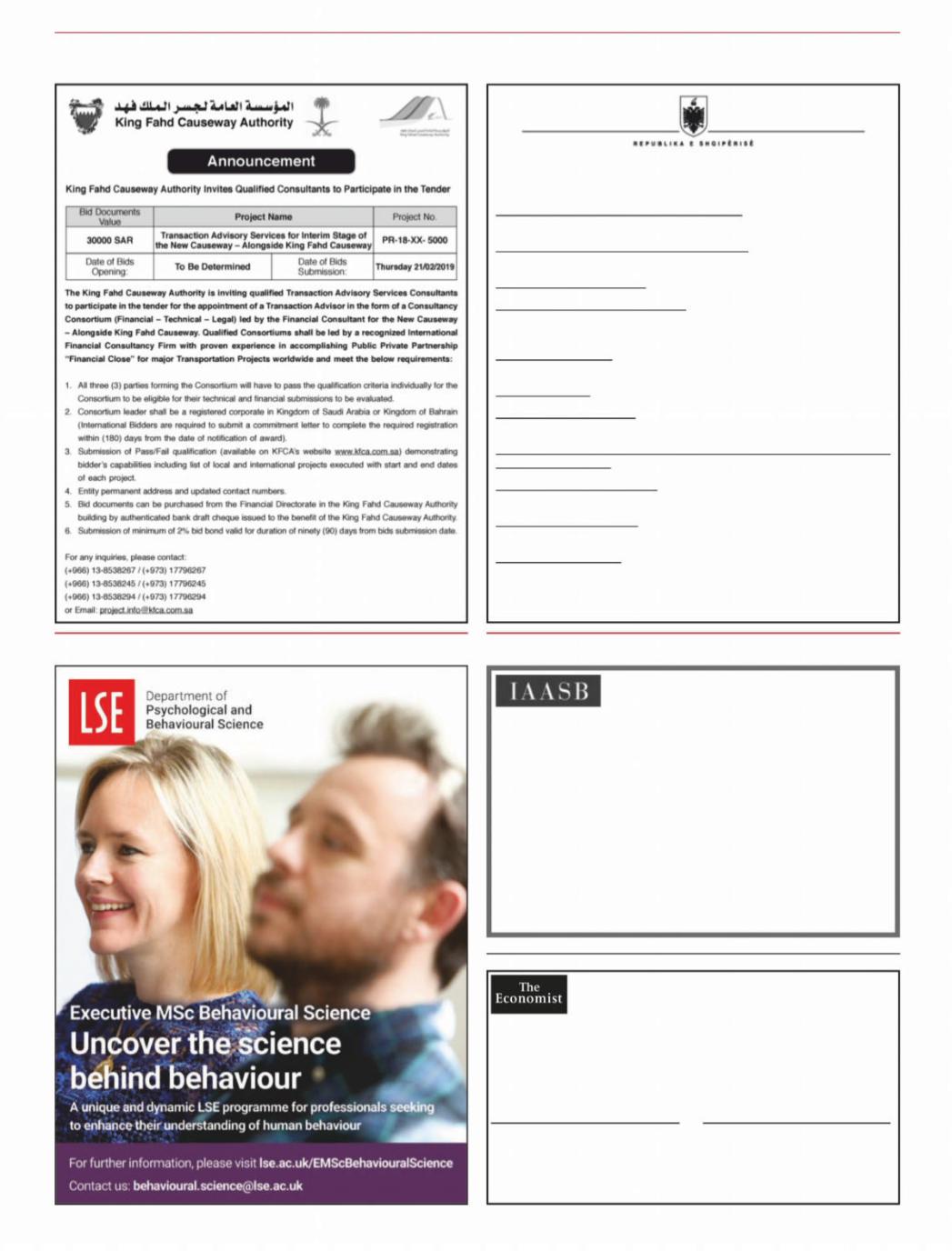
vk.com/id446425943
62 Tenders
MINISTRY OF INFRASTRUCTURE AND ENERGY
NOTIFICATION OF THE CONTRACT
Name and address of the contracting authority: Ministry of Infrastructure and
Energy, Str. Abdi Toptani, No. 1, Tirane
Name and address of the person responsible: Etleva Kondi, Ministry of
Infrastructure and Energy, (e-mail: etleva.kondi@infrastruktura.gov.al)
Type of contracting authority: Central Institution
The form, object and type of contract: The form: Concession/PPP; The object: On the Reinstatement and Operation of Vlora Thermal Power Plant and Optional FierVlora Pipeline Branch (ROOT) and the type of contract is “Work”
Project Forecast Value: The estimated value of the project based on the feasibility study is: approx 58.700.000 Euros
Contract duration: 35 years
The location of the contract: The TPP is located on the Ionian Sea coast, 6 km north of the city of Vlore (Albania).
Legal, economic, financial and technical information and Criteria for the selection of the winner: In accordance with Appendix 9 of ToR
Deadline for submission of bids: Within and not later than: Date 28th of February 2019, 12:00 CEST
Deadline for opening of bids: Within and not later than: Date 28th of February 2019, 12:00 CEST
Period of validity of bids: 180 days
HEAD OF CONTRACTING AUTHORITY
DAMIAN GJIKNURI
Courses |
Appointments |
Chair, International Auditing
and Assurance Standards Board
Seeking an influential leader to be the next Chair of the International Auditing and Assurance Standards Board (IAASB).
The Chair leads the IAASB’s strategic direction and development of high-quality international audit standards and facilitates the consultative processes that underpin the board’s credibility and activities.
The Chair develops and maintains effective relationships with key stakeholders and must be a strong leader with relevant audit or standard-setting experience and a successful track record setting and implementing strategy; building consensus within multi-national and multi-stakeholder environments; and mobilizing volunteer Board.
The IAASB chair is appointed for a renewable three-year term, beginning May 1, 2019. This is a full-time position with a competitive remuneration package. A complete job description is available on the IAASB website at www.iaasb.org. Applications are due by January 31, 2019.
To advertise within the classified section, contact:
UK/Europe |
United States |
Olivia Power |
Richard Dexter |
Tel: +44 20 7576 8539 |
Tel: +1 212 554 0662 |
oliviapower@economist.com |
richarddexter@economist.com |
Asia |
Middle East & Africa |
Shan Shan Teo |
Philip Wrigley |
Tel: +65 6428 2673 |
Tel: +44 20 7576 8091 |
shanshanteo@economist.com |
philipwrigley@economist.com |
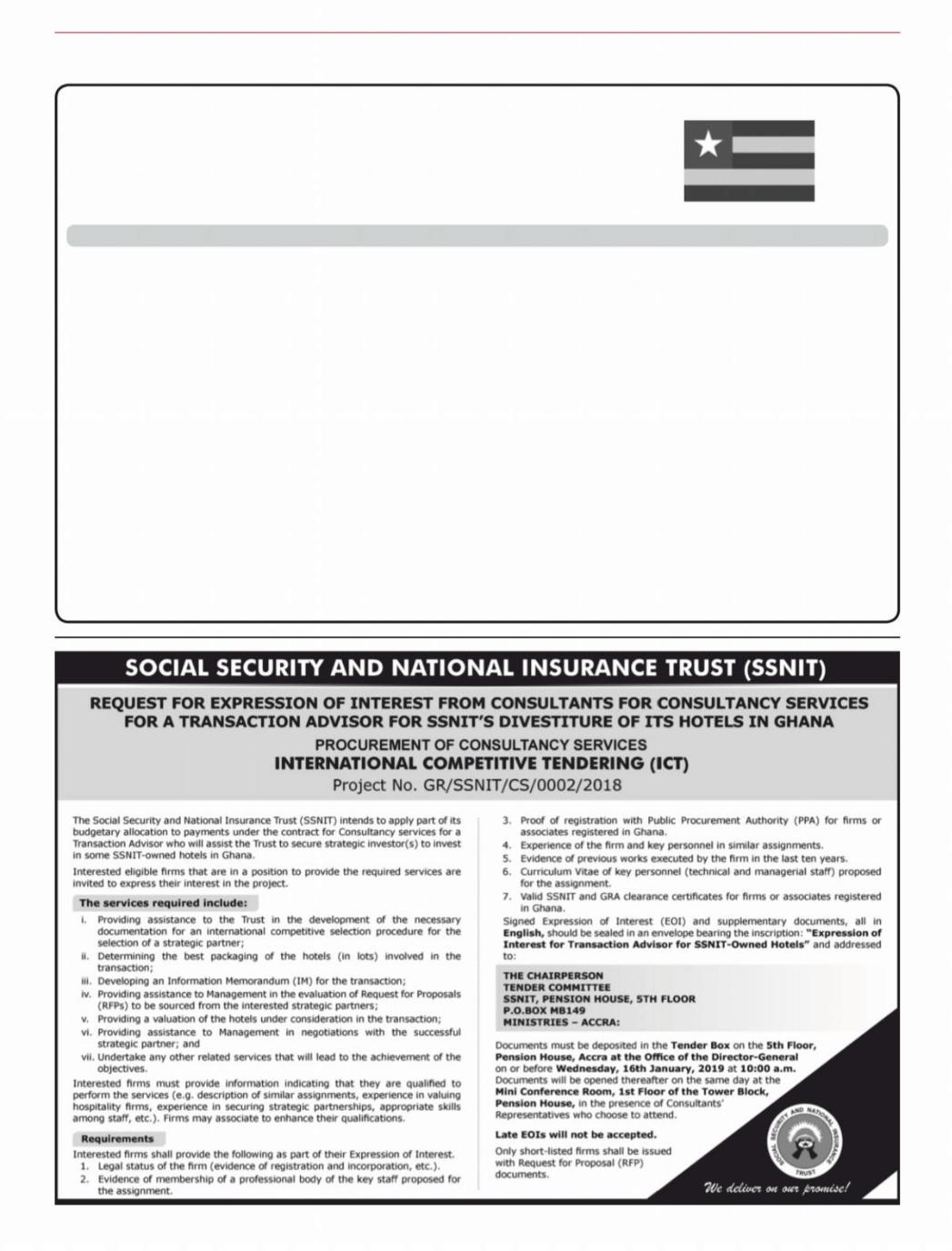
vk.com/id446425943
Tenders |
63 |
TOGOLESE REPUBLIQUE
TENDER NOTICE
SELECTION OF A STRATEGIC PARTNER TO INVEST IN THE CAPITAL OF TOGOCOM
The Togolese Republic has decided to divest part of its participations in Togocom, which holds 100% of the share capital of Togo Telecom and Togo Cellulaire, the fixed and mobile telecommunications operators.
The Togolese Government is organizing a tender process to select a strategic investor.
Interested applicants who wish to receive a copy of the tender documentation shall request it by Wednesday, January 30th, 2019 at 5pm GMT at the address: togocom@numerique.gouv.tg
The receipt of the tender documentation is subject to:
1.Proof that the following eligibility criteria are met:
»More than 5 million (5,000,000) fixed and/or mobile users;
»Presence as an electronic communications operator in at least two (02) countries;
»Operating optical fibre networks more than 1,200 kilometres long.
2.Payment of the cost of the tender documentation, set at seven thousand five hundred (7,500) euros;
3.The execution of a non-disclosure agreement.
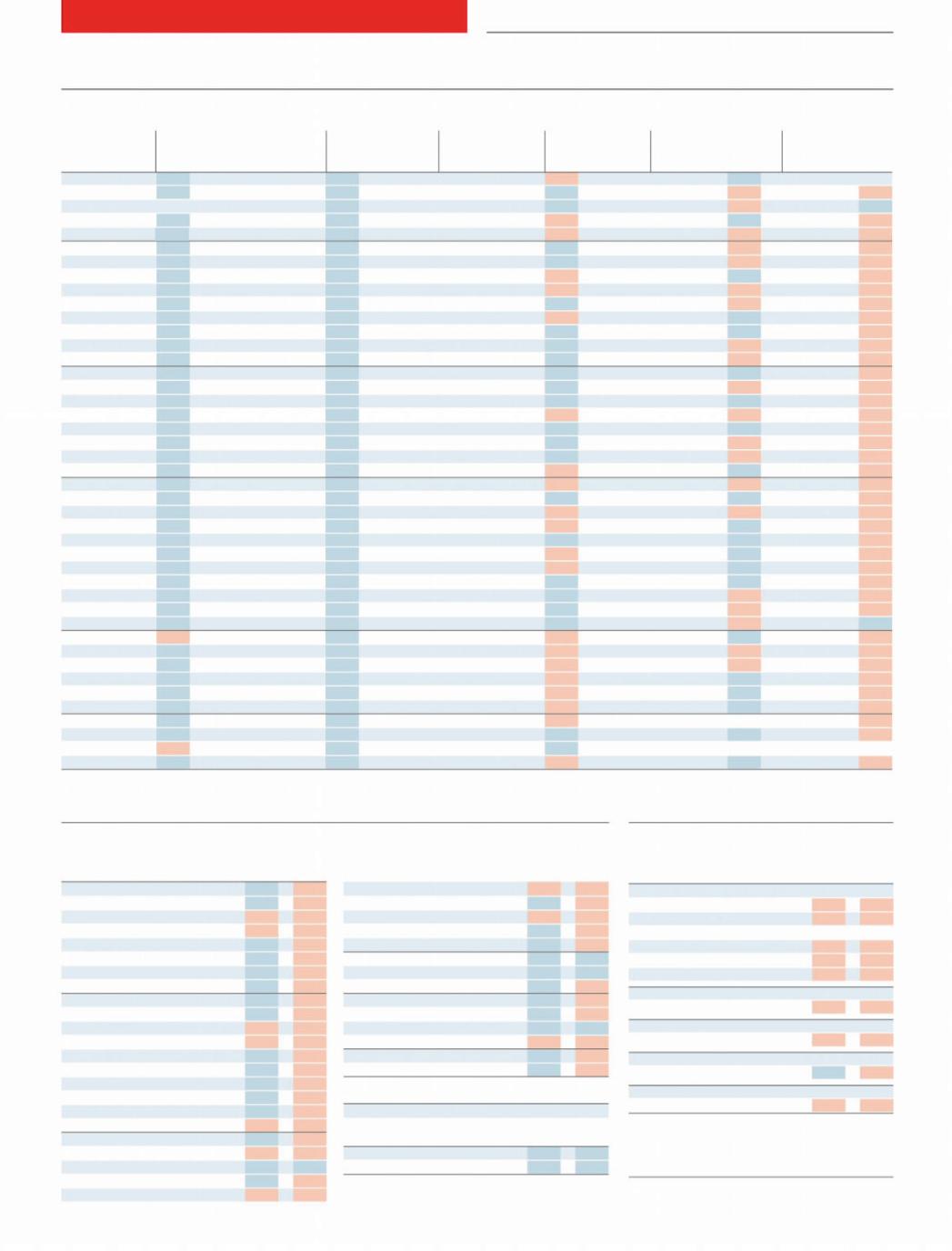
vk.com/id446425943 |
|
|
|
|
|
|
|
|
|
|
|
|
|
|
64 Economic & financial indicators |
|
|
|
The Economist January 5th 2019 |
||||||||||
Economic data |
|
|
|
|
|
|
|
|
|
|
|
|
|
|
|
Gross domestic product |
Consumer prices |
Unemployment |
Current-account |
Interest rates |
Currency units |
||||||||
|
% change on year ago |
|
% change on year ago |
rate |
|
balance |
10-yr gov't bonds change on |
per $ |
% change |
|||||
|
latest |
|
quarter* |
2018† |
latest |
|
2018† |
% |
|
% of GDP, 2018† |
latest,% |
year ago, bp |
Jan 2nd |
on year ago |
United States |
3.0 |
Q3 |
3.4 |
2.9 |
2.2 |
Nov |
2.5 |
3.7 |
Nov |
-2.6 |
2.72 |
29.0 |
- |
|
China |
6.5 |
Q3 |
6.6 |
6.6 |
2.2 |
Nov |
2.1 |
3.8 |
Q3§ |
0.5 |
2.97§§ |
-89.0 |
6.85 |
-5.1 |
Japan |
nil |
Q3 |
-2.5 |
1.1 |
0.9 |
Nov |
0.9 |
2.5 |
Nov |
3.8 |
0.02 |
-4.0 |
109 |
2.6 |
Britain |
1.5 |
Q3 |
2.5 |
1.3 |
2.3 |
Nov |
2.4 |
4.1 |
Sep†† |
-3.4 |
1.34 |
8.0 |
0.79 |
-6.3 |
Canada |
2.1 |
Q3 |
2.0 |
2.3 |
1.7 |
Nov |
2.3 |
5.6 |
Nov |
-2.6 |
1.90 |
-18.0 |
1.36 |
-8.1 |
Euro area |
1.6 |
Q3 |
0.6 |
2.1 |
1.9 |
Nov |
1.7 |
8.1 |
Oct |
3.4 |
0.16 |
-30.0 |
0.88 |
-5.7 |
Austria |
2.2 |
Q3 |
-1.9 |
2.9 |
2.2 |
Nov |
2.1 |
5.1 |
Oct |
2.2 |
0.43 |
-19.0 |
0.88 |
-5.7 |
Belgium |
1.6 |
Q3 |
1.2 |
1.5 |
2.3 |
Dec |
2.2 |
6.2 |
Oct |
-0.3 |
0.76 |
4.0 |
0.88 |
-5.7 |
France |
1.4 |
Q3 |
1.3 |
1.7 |
1.9 |
Nov |
2.1 |
8.9 |
Oct |
-0.9 |
0.71 |
-8.0 |
0.88 |
-5.7 |
Germany |
1.2 |
Q3 |
-0.8 |
1.9 |
1.7 |
Dec |
1.8 |
3.3 |
Oct‡ |
7.9 |
0.16 |
-30.0 |
0.88 |
-5.7 |
Greece |
2.4 |
Q3 |
4.3 |
2.1 |
1.0 |
Nov |
0.8 |
18.6 |
Sep |
-1.3 |
4.40 |
31.0 |
0.88 |
-5.7 |
Italy |
0.7 |
Q3 |
-0.5 |
1.1 |
1.6 |
Nov |
1.4 |
10.6 |
Oct |
2.4 |
2.70 |
60.0 |
0.88 |
-5.7 |
Netherlands |
2.4 |
Q3 |
0.6 |
2.8 |
2.0 |
Nov |
1.7 |
4.4 |
Nov |
10.1 |
0.39 |
-14.0 |
0.88 |
-5.7 |
Spain |
2.5 |
Q3 |
2.2 |
2.7 |
1.2 |
Dec |
1.8 |
14.8 |
Oct |
1.1 |
1.41 |
-9.0 |
0.88 |
-5.7 |
Czech Republic |
2.5 |
Q3 |
2.3 |
2.8 |
2.0 |
Nov |
2.3 |
2.1 |
Oct‡ |
0.8 |
1.80 |
14.0 |
22.7 |
-6.7 |
Denmark |
2.4 |
Q3 |
2.9 |
1.3 |
0.8 |
Nov |
1.1 |
3.9 |
Oct |
7.2 |
0.16 |
-35.0 |
6.58 |
-6.1 |
Norway |
1.1 |
Q3 |
2.3 |
1.7 |
3.5 |
Nov |
2.7 |
4.0 |
Sep‡‡ |
8.5 |
1.79 |
14.0 |
8.70 |
-6.4 |
Poland |
5.7 |
Q3 |
7.0 |
5.1 |
1.3 |
Nov |
1.7 |
5.7 |
Nov§ |
-0.4 |
2.75 |
-56.0 |
3.78 |
-8.5 |
Russia |
1.5 |
Q3 |
na |
1.6 |
4.2 |
Dec |
2.9 |
4.8 |
Nov§ |
5.1 |
8.81 |
115 |
68.8 |
-16.3 |
Sweden |
1.7 |
Q3 |
-0.9 |
2.7 |
2.0 |
Nov |
2.0 |
5.5 |
Nov§ |
3.8 |
0.47 |
-28.0 |
8.99 |
-9.0 |
Switzerland |
2.4 |
Q3 |
-0.9 |
2.7 |
0.9 |
Nov |
1.0 |
2.4 |
Nov |
9.9 |
-0.15 |
-6.0 |
0.99 |
-2.0 |
Turkey |
1.6 |
Q3 |
na |
3.8 |
21.6 |
Nov |
15.3 |
11.4 |
Sep§ |
-5.7 |
16.6 |
495 |
5.38 |
-30.1 |
Australia |
2.8 |
Q3 |
1.0 |
3.2 |
1.9 |
Q3 |
2.1 |
5.1 |
Nov |
-2.6 |
2.29 |
-37.0 |
1.42 |
-9.9 |
Hong Kong |
2.9 |
Q3 |
0.3 |
3.4 |
2.6 |
Nov |
2.4 |
2.8 |
Nov‡‡ |
2.3 |
1.95 |
13.0 |
7.83 |
-0.1 |
India |
7.1 |
Q3 |
3.3 |
7.4 |
2.3 |
Nov |
4.6 |
7.4 |
Dec |
-2.4 |
7.35 |
-4.0 |
70.1 |
-9.5 |
Indonesia |
5.2 |
Q3 |
na |
5.2 |
3.1 |
Dec |
3.4 |
5.3 |
Q3§ |
-2.6 |
7.90 |
160 |
14,455 |
-6.5 |
Malaysia |
4.4 |
Q3 |
na |
4.7 |
0.2 |
Nov |
0.8 |
3.3 |
Oct§ |
2.3 |
4.07 |
15.0 |
4.14 |
-2.9 |
Pakistan |
5.4 |
2018** |
na |
5.4 |
6.2 |
Dec |
5.2 |
5.9 |
2015 |
-5.7 |
13.2††† |
522 |
139 |
-20.6 |
Philippines |
6.1 |
Q3 |
5.7 |
6.2 |
6.0 |
Nov |
5.3 |
5.1 |
Q4§ |
-2.4 |
7.04 |
134 |
52.5 |
-5.0 |
Singapore |
2.2 |
Q4 |
1.6 |
3.5 |
0.3 |
Nov |
0.6 |
2.1 |
Q3 |
19.1 |
2.05 |
5.0 |
1.37 |
-2.9 |
South Korea |
2.0 |
Q3 |
2.3 |
2.8 |
1.3 |
Dec |
1.6 |
3.2 |
Nov§ |
4.5 |
1.95 |
-54.0 |
1,119 |
-5.2 |
Taiwan |
2.3 |
Q3 |
1.5 |
2.6 |
0.3 |
Nov |
1.4 |
3.7 |
Nov |
12.9 |
0.85 |
-7.0 |
30.8 |
-3.8 |
Thailand |
3.3 |
Q3 |
-0.1 |
4.1 |
0.4 |
Dec |
1.2 |
1.0 |
Nov§ |
7.8 |
2.20 |
-9.0 |
32.3 |
1.1 |
Argentina |
-3.5 |
Q3 |
-2.7 |
-2.3 |
48.0 |
Nov |
33.6 |
9.0 |
Q3§ |
-4.3 |
11.3 |
562 |
38.0 |
-51.2 |
Brazil |
1.3 |
Q3 |
3.1 |
1.5 |
4.0 |
Nov |
3.8 |
11.6 |
Nov§ |
-1.0 |
7.22 |
-143 |
3.81 |
-14.4 |
Chile |
2.8 |
Q3 |
1.1 |
3.9 |
2.8 |
Nov |
2.5 |
6.8 |
Nov§‡‡ |
-2.2 |
4.21 |
-33.0 |
697 |
-12.9 |
Colombia |
2.6 |
Q3 |
0.9 |
2.6 |
3.3 |
Nov |
3.2 |
8.8 |
Nov§ |
-3.2 |
7.09 |
64.0 |
3,251 |
-9.7 |
Mexico |
2.5 |
Q3 |
3.4 |
2.1 |
4.7 |
Nov |
4.8 |
3.3 |
Nov |
-1.8 |
8.64 |
105 |
19.6 |
-0.3 |
Peru |
2.3 |
Q3 |
-8.3 |
3.7 |
2.2 |
Dec |
1.3 |
5.7 |
Nov§ |
-2.2 |
5.65 |
47.0 |
3.37 |
-3.9 |
Egypt |
5.4 |
Q2 |
na |
5.3 |
15.7 |
Nov |
17.0 |
10.0 |
Q3§ |
-2.0 |
na |
nil |
17.9 |
-1.0 |
Israel |
2.9 |
Q3 |
2.1 |
3.4 |
1.2 |
Nov |
0.8 |
4.1 |
Nov |
1.7 |
2.26 |
60.0 |
3.74 |
-7.5 |
Saudi Arabia |
-0.9 |
2017 |
na |
1.5 |
2.8 |
Nov |
2.6 |
6.0 |
Q2 |
8.0 |
na |
nil |
3.75 |
nil |
South Africa |
1.1 |
Q3 |
2.2 |
0.7 |
5.2 |
Nov |
4.8 |
27.5 |
Q3§ |
-3.5 |
8.94 |
33.0 |
14.4 |
-13.6 |
Source: Haver Analytics. *% change on previous quarter, annual rate. †The Economist poll or Economist Intelligence Unit estimate/forecast. §Not seasonally adjusted. ‡New series. **Year ending June. ††Latest 3 months. ‡‡3-month moving average. §§5-year yield. †††Dollar-denominated bonds.
Markets
|
|
% change on: |
|
|
Index |
one |
Dec 29th |
|
Jan 2nd |
week |
2017 |
United States S&P 500 |
2,510.0 |
1.7 |
-6.1 |
United States NAScomp |
6,665.9 |
1.7 |
-3.4 |
China Shanghai Comp |
2,465.3 |
-1.3 |
-25.5 |
China Shenzhen Comp |
1,256.4 |
-1.8 |
-33.9 |
Japan Nikkei 225 |
20,014.8 |
3.6 |
-12.1 |
Japan Topix |
1,494.1 |
4.4 |
-17.8 |
Britain FTSE 100 |
6,734.2 |
0.7 |
-12.4 |
Canada S&P TSX |
14,347.2 |
4.1 |
-11.5 |
Euro area EURO STOXX 50 |
2,993.2 |
0.7 |
-14.6 |
France CAC 40 |
4,689.4 |
1.4 |
-11.7 |
Germany DAX* |
10,580.2 |
-0.5 |
-18.1 |
Italy FTSE/MIB |
18,331.0 |
-0.4 |
-16.1 |
Netherlands AEX |
486.6 |
1.7 |
-10.7 |
Spain IBEX 35 |
8,550.0 |
0.8 |
-14.9 |
Poland WIG |
58,290.2 |
1.7 |
-8.6 |
Russia RTS, $ terms |
1,066.1 |
1.2 |
-7.6 |
Switzerland SMI |
8,429.3 |
0.1 |
-10.2 |
Turkey BIST |
88,865.0 |
-2.3 |
-22.9 |
Australia All Ord. |
5,625.6 |
1.2 |
-8.8 |
Hong Kong Hang Seng |
25,130.4 |
-2.0 |
-16.0 |
India BSE |
35,891.5 |
0.7 |
5.4 |
Indonesia IDX |
6,181.2 |
0.9 |
-2.7 |
Malaysia KLSE |
1,668.1 |
-0.3 |
-7.2 |
|
|
% change on: |
|
|
index |
one |
Dec 29th |
|
Jan 2nd |
week |
2017 |
Pakistan KSE |
37,795.3 |
-1.1 |
-6.6 |
Singapore STI |
3,038.9 |
0.9 |
-10.7 |
South Korea KOSPI |
2,010.0 |
-0.9 |
-18.5 |
Taiwan TWI |
9,554.1 |
0.8 |
-10.2 |
Thailand SET |
1,565.9 |
0.6 |
-10.7 |
Argentina MERV |
31,096.6 |
9.2 |
3.4 |
Brazil BVSP |
91,012.3 |
6.9 |
19.1 |
Mexico IPC |
42,271.1 |
1.7 |
-14.4 |
Egypt EGX 30 |
13,204.4 |
2.8 |
-12.1 |
Israel TA-125 |
1,334.2 |
1.4 |
-2.2 |
Saudi Arabia Tadawul |
7,790.9 |
1.0 |
7.8 |
South Africa JSE AS |
51,264.1 |
-1.6 |
-13.8 |
World, dev'd MSCI |
1,881.1 |
1.6 |
-10.6 |
Emerging markets MSCI |
955.7 |
0.6 |
-17.5 |
US corporate bonds, spread over Treasuries |
|
|
|
|
|
|
Dec 29th |
Basis points |
|
latest |
2017 |
Investment grade |
|
190 |
137 |
High-yield |
|
571 |
404 |
Sources: Datastream from Refinitiv; Standard & Poor's Global Fixed Income Research. *Total return index.
Commodities |
|
|
|
|
|
The Economist commodity-price index |
% change on |
||||
|
|
|
|
||
2005=100 |
Dec 14th |
24th |
31st* |
month |
year |
Dollar Index |
|
|
|
|
|
All Items |
137.2 |
136.4 |
135.9 |
-2.2 |
-9.9 |
Food |
144.3 |
144.5 |
144.1 |
-0.3 |
-3.6 |
Industrials |
|
|
|
|
|
All |
129.8 |
127.9 |
127.5 |
-4.3 |
-16.3 |
Nfa† |
121.8 |
119.3 |
119.2 |
-2.0 |
-13.6 |
Metals |
133.3 |
131.6 |
131.1 |
-5.2 |
-17.3 |
Sterling Index |
|
|
|
|
|
All items |
198.7 |
195.0 |
194.1 |
-2.2 |
-3.9 |
Euro Index |
|
|
|
|
|
All items |
151.0 |
148.6 |
147.9 |
-2.9 |
-5.1 |
Gold |
|
|
|
|
|
$ per oz |
1,238.7 |
1,265.5 |
1,281.3 |
3.5 |
-2.4 |
West Texas Intermediate |
|
|
|
||
$ per barrel |
51.2 |
42.5 |
45.4 |
-14.7 |
-24.8 |
Sources: CME Group; Cotlook; Darmenn & Curl; Datastream from Refinitiv; FT; ICCO; ICO; ISO; Live Rice Index; LME; NZ Wool Services; Thompson Lloyd & Ewart; Urner Barry; WSJ. *Provisional
†Non-food agriculturals.
For more countries and additional data, visit
Economist.com/indicators
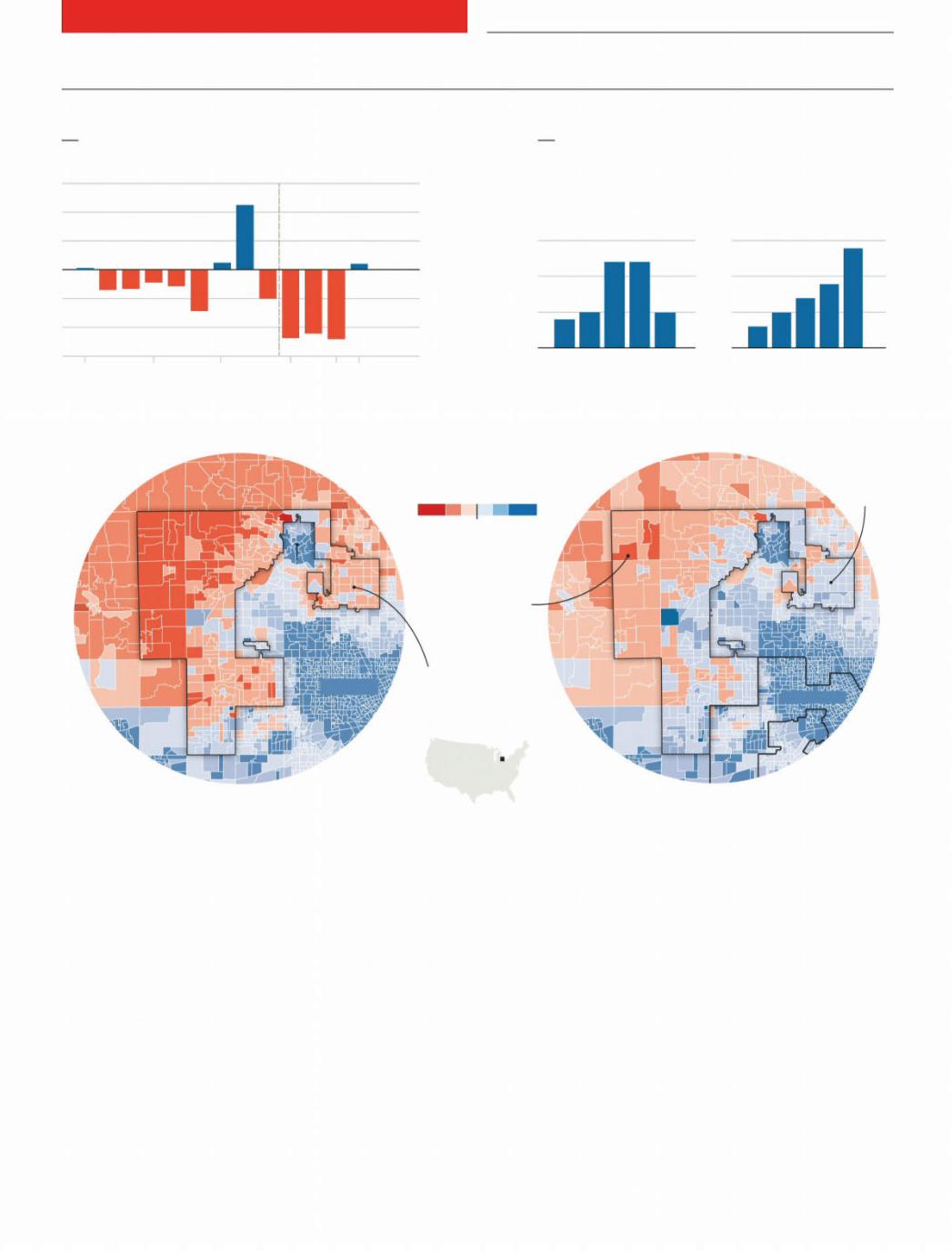
vk.com/id446425943
Graphic detail
The bias favouring Republicans in the House of Representatives vanished in 2018
Share of seats minus share of popular vote
Democratic Party, percentage points
Republican-dominated redistricting in 2011
↑Democrats over-represented
↓Republicans over-represented
1994 |
2000 |
06 |
12 |
16 |
18 |
6
4
2
0
-2
-4
-6
The Economist January 5th 2019 65
Democratic gains among educated, suburban whites distributed the party’s votes more efficiently
Democratic seat gains in 2018
By population density |
|
By education gap among whites |
||
Population per square mile |
College minus non-college, |
|||
|
|
|
% of whites aged 25+ |
|
|
|
15 seats |
|
15 |
|
|
10 |
|
10 |
|
|
5 |
|
5 |
|
|
0 |
|
0 |
Rural |
Suburban |
Urban |
← less |
more → |
|
|
|
educated |
educated |
Michigan 11th
2016 |
Michigan’s 11th district was gerrymandered |
2018 |
|||||
|
|
to protect Republicans. In 2018, |
|
||||
|
|
Democrats won anyway |
|
||||
|
|
Vote margin, by precinct, % |
Michigan 11th |
||||
|
|
R |
|
|
|
D |
|
|
|
|
|
|
|
||
|
|
100 |
50 |
0 |
50 |
100 |
|
|
Pontiac |
|
Republicans still won |
|
|
||
|
Troy |
middle-class exurbs like |
|
||||
|
|
|
|||||
Milford and Highland, but with reduced margins
Republican mapmakers DETROIT gerrymandered around
plurality-black Pontiac to include Troy, a rich suburb
In 2018, Troy flipped to the Democrats
Michigan 13th*
Detroit
America’s House of Representatives
The failure of gerrymandering
How educated, suburban whites ended the over-representation of Republicans
Ever since district borders in America’s House of Representatives were redrawn in 2011, Republicans’ share of seats has exceeded their proportion of the vote. In 2012 Democrats won 51% of the two-party vote
but just 46% of seats.
The Congress that began on January 3rd, however, has no such imbalance. Democrats won 54% of the total two-party vote— and also 54% of House seats. Whatever became of the vaunted pro-Republican bias?
America’s political geography is shaped
Sources: Michigan Department of State; Edison Research; Daily Kos *In uncontested districts, including Michigan’s 13th in 2018, we have imputed the most likely results
by education. In presidential contests the most influential voters are whites without college degrees, who cluster in “swing” states. By contrast, in House elections, white college graduates are unusually valuable, congregating in suburban districts where both parties are competitive.
Donald Trump has rearranged American politics, by courting working-class whites and alienating educated ones. That helped Republicans win the presidency. It should have hurt them in the House. But in 2016 the party got the best of both worlds, because many conservative whites with degrees split their tickets. In states whose presidential winner was never in doubt, they chose Hillary Clinton. But perhaps because they expected her to win and wanted a check on her power, they backed House Republicans in narrowly decided districts.
That changed in 2018, when educated whites abandoned Republican House can-
didates. Because Democrats were already competitive in suburbs, they needed only small swings. They won 13 of the 15 Repub- lican-held districts where a majority of white voters have college degrees. That made the Democratic vote more e cient. In 2016 the party won17 seats by single-dig- it margins; this time they took 40.
And what about gerrymandering, widely thought to protect incumbents? Republicans did draw the borders of more districts than Democrats did. But they only ran the process in 37% of seats. Of the 42 seats the party lost, it had gerrymandered just nine.
Those nine seats, however, show that extreme gerrymandering is risky. Many Republican mapmakers tried to neutralise Democratic voters by burying them in suburban districts full of educated whites. They never imagined that this ruse would backfire, but Mr Trump drove these onceloyal Republicans into Democrats’ arms. 7
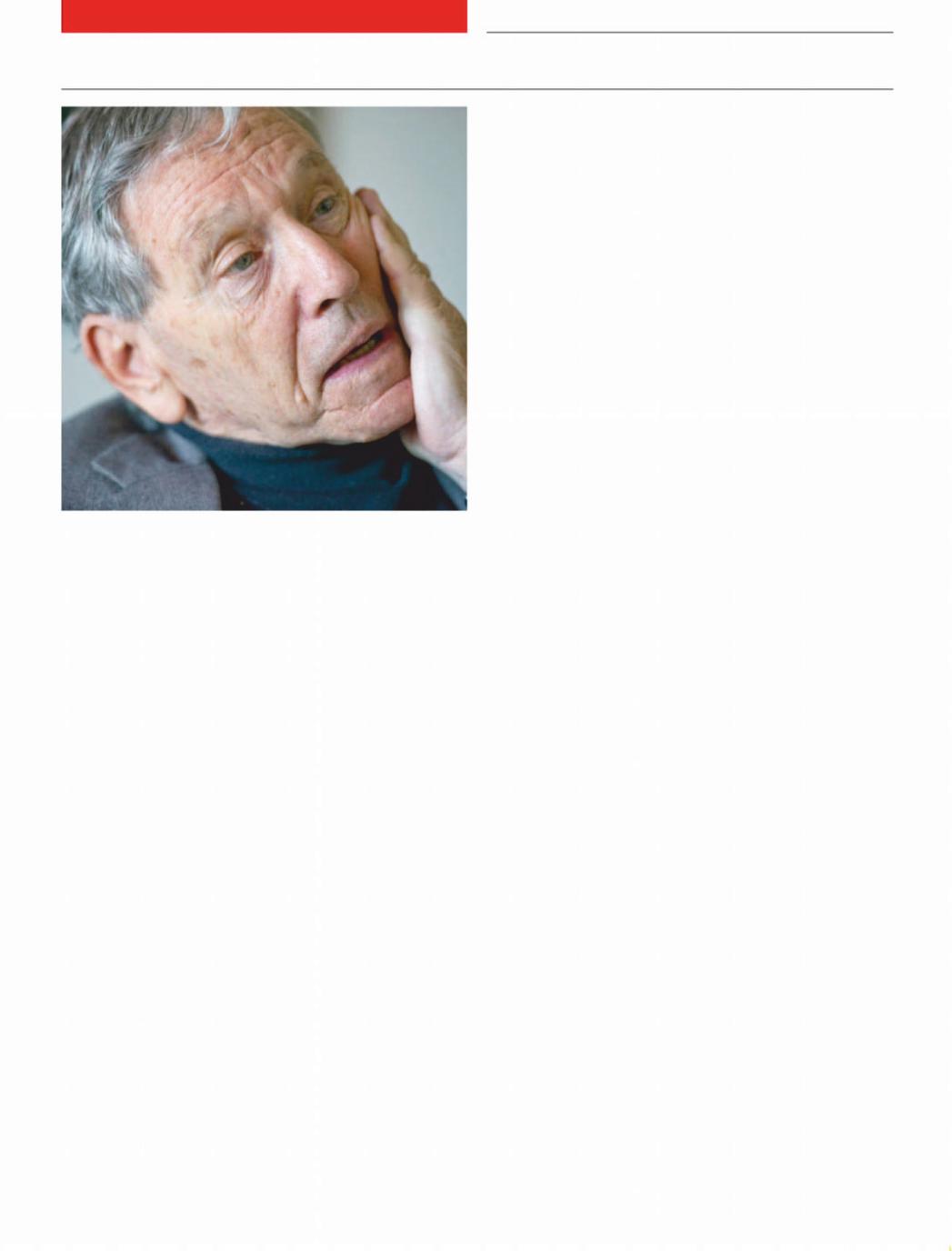
vk.com/id446425943
66 Obituary Amos Oz
A torn Israeli
Amos Oz, a celebrated writer of novels and essays, died on December 28th, aged 79
When his father had to choose a primary school, Amos Oz had two alternatives within walking distance of the family home in1940s Jerusalem— a religious institution and one belonging to a
socialist-Zionist workers’ union. A staunchly secular librarian and right-wing nationalist, Mr Oz’s father chose to send the boy to the religious school, reckoning the important thing was that young Amos did not become a Bolshevik. Socialism was spreading like wildfire, he thought, but religion was on the wane and would soon disappear from the land.
That proved short-sighted, both on a national and a personal level. In the new state of Israel, the socialists would dominate for the first three decades but then gradually lose their dominance. Whereas religion endured. As for young Amos, shaken by his mother’s depression-driven suicide, he would rebel against his father, leaving Jerusalem at 14 to become a member of a kibbutz, a socialist-Zionist collective agricultural community. Haunted, he would try to use his life there to recreate himself, even changing his name from the Ashkenazi Klausner, to “Oz”, a short, stark Hebrew word meaning strength and courage. Years later he said it was the only thing he lacked.
At the kibbutz he had the status of a yeled chutz—an outside child, striving to belong, but also constantly observing from without. He tried to conform with the austere mores, working in the fields and, at 18, serving in a tough combat unit while writing at night. Fortunately for him, the kibbutz movement also saw the need for ideologues. He was appointed a teacher and allowed to study philosophy and literature, back in Jerusalem at the Hebrew University. His early work, like him, was split by the challenges of the Utopian experiment of the kibbutz he tried so hard to be a part of and the ancient phobia of Jerusalem that he never escaped.
His first collection of short stories, “Where the Jackals Howl” (1965), and his first novel, “Elsewhere, Perhaps” (1966), dealt with
The Economist January 5th 2019
kibbutz life. But instead of describing his fellow young kibbutzniks as having found peace and satisfaction tilling the land, he wrote of their “sadness of distance”, how “their hearts go out to other places that are not specific, but are far.” His own heart returned to his birthplace. The novel that made his name, “My Michael” (1968), was about the tortured fantasies of an anguished young woman, married to a mediocre academic and struggling to raise her young son in1950s Jerusalem.
“My Michael” established him as Israel’s foremost young writer and over the years was translated into more than 30 languages. Only in 2002, when his epic memoir, “A Tale of Love and Darkness”, was published, did it become clear that all along he had been writing about his own parents. Yet literary success and confronting his own personal demons was never enough for him; he publicly wrestled with Israel’s internal furies throughout his writing career, struggling to realise, in his work, as in his life, the brave new Jewish state.
In 1967 he was drafted during the six-day war to serve as a speechwriter for Israel’s victorious generals. He believed in the war as a justified action of defence against hostile Arab neighbours, but soon after, as Israel began to grapple with the realities of a military occupation of millions of Palestinians in the West Bank and Gaza, he was one of the first to give warning to his fellow citizens. “We were not born to be a nation of masters,” he wrote in a column in Davar, the ruling Socialist Party’s newspaper. Ten years later, Likud came to power. Except for brief periods, Israel has been ruled ever since by a coalition of right-wing and religious nationalists bent on remaining masters of the land.
Success as a fiction writer did not curb his burning need to be a political polemicist as well. He became one of the leading lights of Israel’s peace camp, a confidant of politicians including Shimon Peres when prime minister and president. At the same time he tried repeatedly to engage with the Jewish settlers in the West Bank and others in Israeli society with whom he had bitter di erences. Much of his international renown was owing to his 19 novels and short-story collections, but for many Israelis, the accounts of his journeys across the land and his meetings with its inhabitants were of even greater importance. “In the Land of Israel”, a collection of his essays from the early 1980s, focusing on conversations with Israelis and Palestinians, became a pivotal documentary on life in Israel and the West Bank, mapping out the fault-lines that divided the di erent groups living in a contested land.
As the Israeli occupation of Palestinians continued unresolved, Mr Oz increasingly found himself harshly criticising his country at home, while defending it abroad—as did other liberal Israelis with prominent voices. On his 75th birthday in Tel Aviv, he warned of the presence of “Hebrew neo-Nazis” in Israel. However, he supported Israel’s recent wars in Lebanon and Gaza as necessary acts of defence against “the dark shadows of Iran, Syria and fanatic Islam” and argued Israel’s case with a historical comparison he had made in his memoir: “Out there, in the world, all the walls were covered with gra ti: ‘Yids, go back to Palestine’, so we came back to Palestine, and now the world at large shouts at us: ‘Yids, get out of Palestine.’”
His last novel, “Judas” (2014), marked his literary return to Jerusalem, to those young doomed academics, like his parents in Israel’s early years, struggling to make sense of Jewish history and of their own present. The characters tear themselves apart over questions of loyalty and treachery to each other, their nation and their ideals.
Like the Judas of his book, he never found peace. He had left the divided city 60 years earlier, but was never fully at home in the kibbutz. In1985 he moved to the desert town of Arad, but lived his last years in liberal, secular Tel Aviv. He continued to write, publishing collections of essays on Jewish literature, fanaticism and love. In one of his last interviews, two months before his death, he called himself simply “an involved citizen who writes a lot”. 7
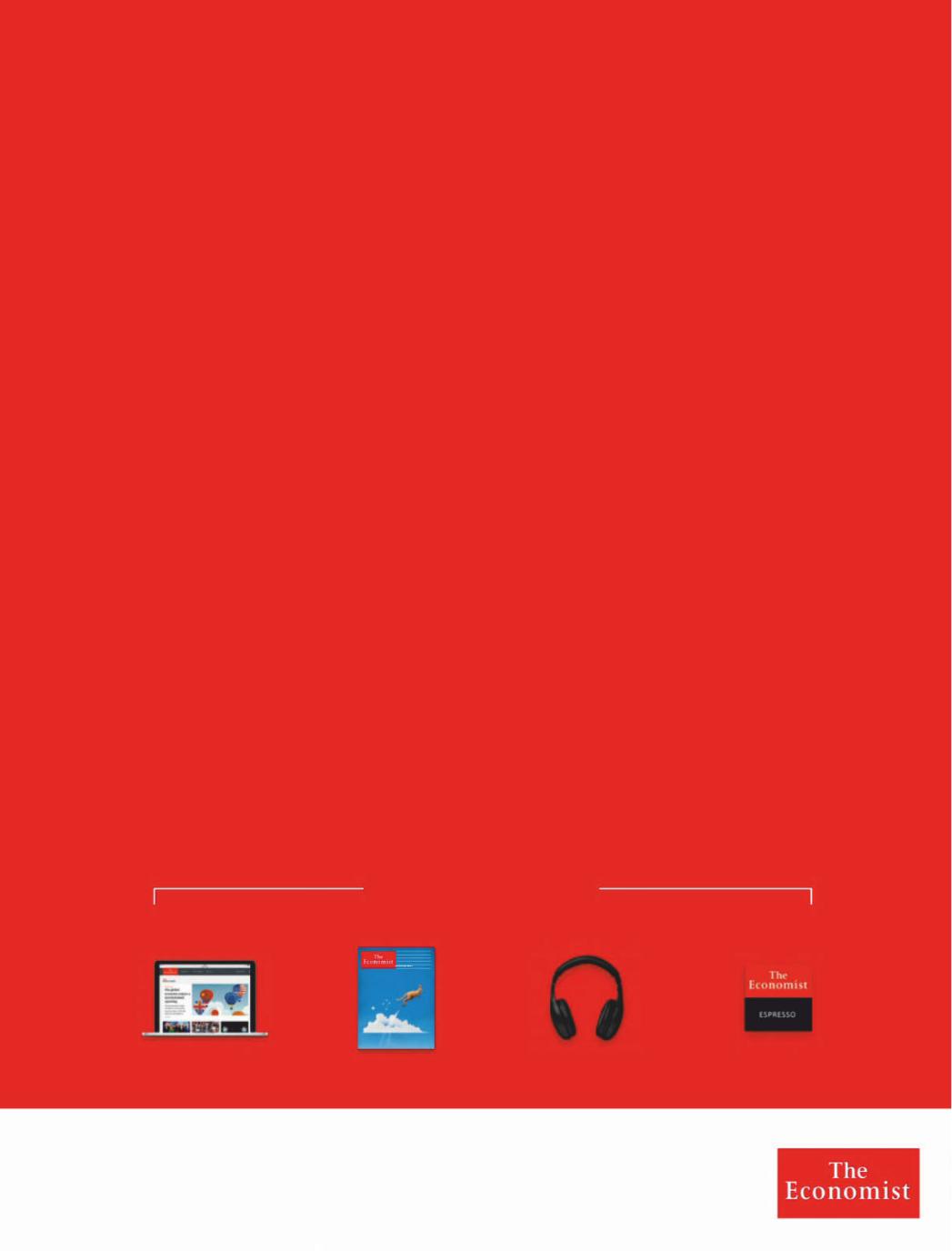
vk.com/id446425943
This year, why not spend more time on the important things in life?
Your time is precious. So you’ll want to know it’s well spent. A weekly subscription to The Economist gives you
a deeper understanding of world events.
SUBSCRIBERS ENJOY:
Trump and he caravan
How to protect Brazil’s democracy
The case against gender se f ID
Drone deliveries take off
Aussie rules
What Australia can teach the world
Yet to subscribe? Visit Economist.com/2019 to get started. Enjoy access across print and digital for just $12 for 12 weeks and receive a free Economist notebook.
